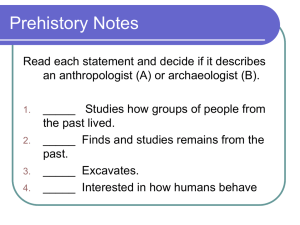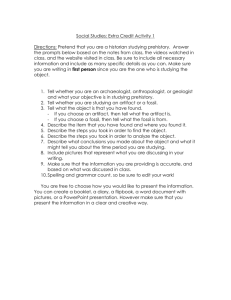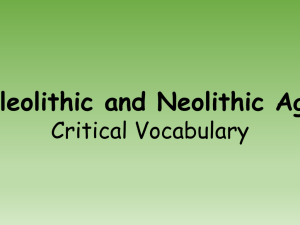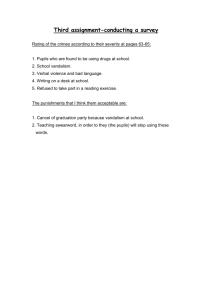Prehistory and Mesopotamia Study Guide
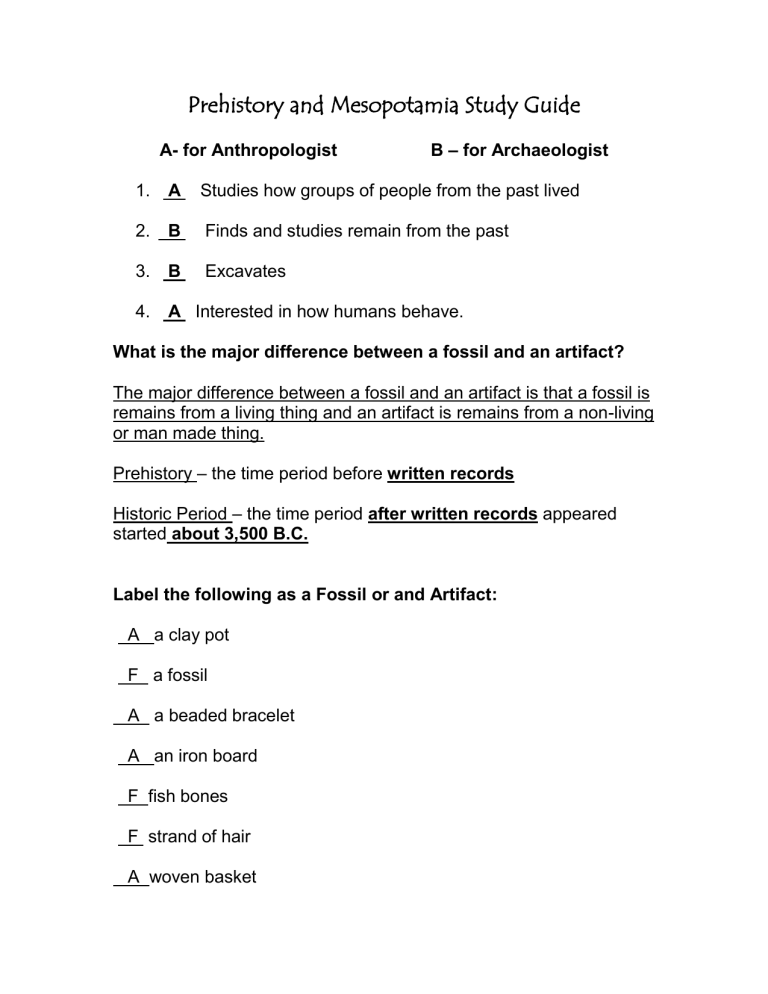
Prehistory and Mesopotamia Study Guide
A- for Anthropologist B – for Archaeologist
1. A Studies how groups of people from the past lived
2. B Finds and studies remain from the past
3. B Excavates
4. A Interested in how humans behave.
What is the major difference between a fossil and an artifact?
The major difference between a fossil and an artifact is that a fossil is remains from a living thing and an artifact is remains from a non-living or man made thing.
Prehistory – the time period before written records
Historic Period – the time period after written records appeared started about 3,500 B.C.
Label the following as a Fossil or and Artifact:
A a clay pot
F a fossil
A a beaded bracelet
A an iron board
F fish bones
F strand of hair
A woven basket
What were nomads? Nomads were groups of 20-30 people that moved around in search of food (hunting and gathering)
Why did people have to live this way during the Stone Age?
People lived this way during the Paleolithic Age people needed search for food to survive when the food supply in an area ran out.
Tell why each change was important?
Advanced tools were important because it made killing large animals easier and allowed people to catch more animals.
Advanced tools were also important so they people could dig and clean animal skins better and advanced farming tools were developed.
Language was important because it provided communication for information and emotions. It also enabled people to pass on information and work together easier.
The Discovery of Fire was important because o Provided warmth o Provided light o Scare away animals o Place to gather o Cooked food was easier to digest and could be stored
What does Agriculture mean?
Farming
The development of Agriculture allowed nomads to stay in one place, store food and develop village life.
Specialization of Labor – people would train (specialize) in one specific job
This is important because it allowed people to focus on one job and trade for other needs
Five Traits of Civilization:
Record Keeping – a way of keeping track of data
Advanced Cities – centers of trade
Complex Institutions – organized groups of people who have something in common
Specialized Workers – a worker with a special skill
Advanced Technology – new inventions and ideas that make life easier or solve problems
Mesopotamia:
Environmental Challenges:
Lack of natural resources – traded with different city-states
Unpredictable flooding – built irrigation canals or ditches to control the water to the farms
No Natural Barriers/defenseless against attacks – built mud brick walls around the cities
The ONLY natural resource that was found in Mesopotamia and was used for all buildings and walls was: mud/clay
Surplus – extra/more than you need
* The farmers could grow a surplus of food because the rivers, flooded, leaving behind a rich, fertile soil called silt.
Hammurabi’s Code of Law:
Written on stone for everyone to see
Basic Philosophy: An Eye for and Eye. o This m eans the punishment must “fit” the crime
Read the two cases below. Why are the punishments different?
Case #1: A nobleman runs down a common women with his horse.
Her donkey runs off and her arm is broken. His punishment is to pay a small fine to the women.
Case #2: A nobleman runs down a noblewomen with his horse. Her donkey runs off and her arm is broken. His punishment is to have his arm broken.
The punishments are different because it depends on which level of the social pyramid the person who committed the crime and the victim where on for the punishment to be determined. If you a person of a higher class committed a crime against a lower class then the punishment was not as harsh as if the victim was of the same class or higher.
Language and Religion
A ziggurat was a pyramid- shaped temple in the middle of each city.
Polytheism is the belief in more than one god.
Wedge-shaped writing in Mesopotamia was called cuneiform .
